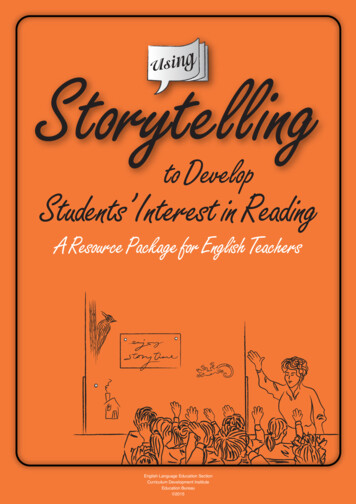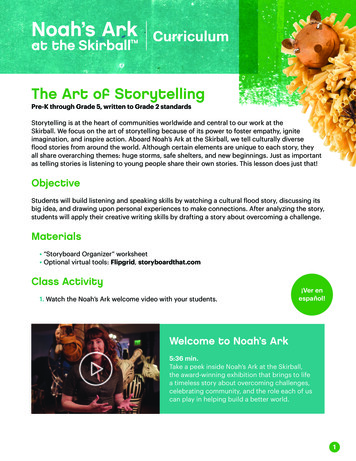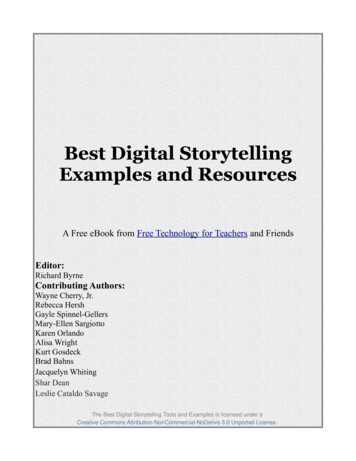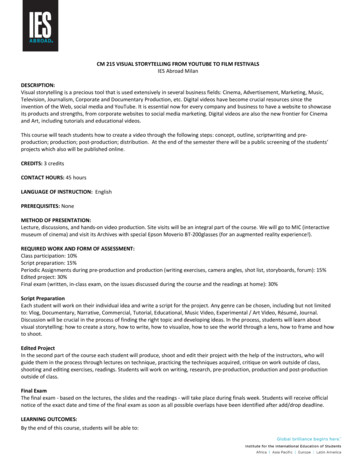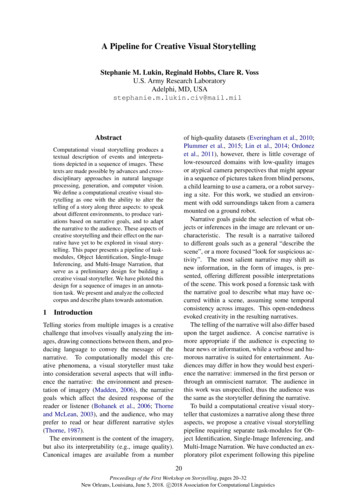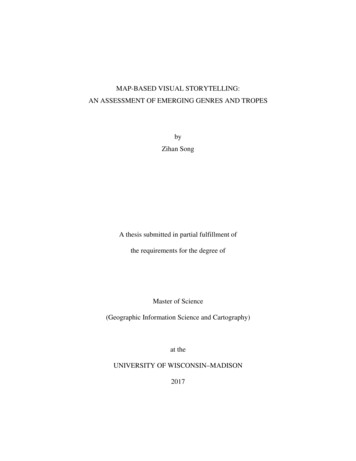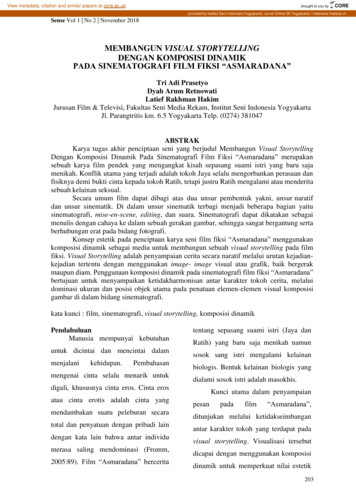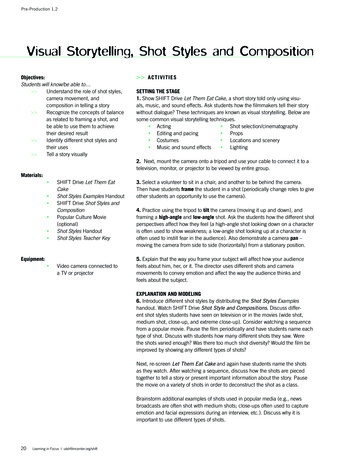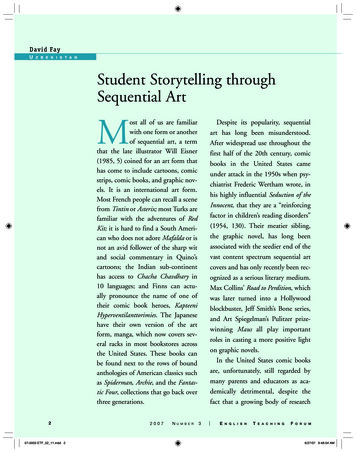
Transcription
David FayUZ B E K I S T A NStudent Storytelling throughSequential ArtMost all of us are familiarwith one form or anotherof sequential art, a termthat the late illustrator Will Eisner(1985, 5) coined for an art form thathas come to include cartoons, comicstrips, comic books, and graphic novels. It is an international art form.Most French people can recall a scenefrom Tintin or Asterix; most Turks arefamiliar with the adventures of RedKit; it is hard to find a South American who does not adore Mafalda or isnot an avid follower of the sharp witand social commentary in Quino’scartoons; the Indian sub-continenthas access to Chacha Chavdhary in10 languages; and Finns can actually pronounce the name of one oftheir comic book heroes, KapteeniHyperventilanttorimies. The Japanesehave their own version of the artform, manga, which now covers several racks in most bookstores acrossthe United States. These books canbe found next to the rows of boundanthologies of American classics suchas Spiderman, Archie, and the Fantastic Four, collections that go back overthree generations.207-0003 ETF 02 11.indd 22007NU M B E RDespite its popularity, sequentialart has long been misunderstood.After widespread use throughout thefirst half of the 20th century, comicbooks in the United States cameunder attack in the 1950s when psychiatrist Frederic Wertham wrote, inhis highly influential Seduction of theInnocent, that they are a “reinforcingfactor in children’s reading disorders”(1954, 130). Their meatier sibling,the graphic novel, has long beenassociated with the seedier end of thevast content spectrum sequential artcovers and has only recently been recognized as a serious literary medium.Max Collins’ Road to Perdition, whichwas later turned into a Hollywoodblockbuster, Jeff Smith’s Bone series,and Art Spiegelman’s Pulitzer prizewinning Maus all play importantroles in casting a more positive lighton graphic novels.In the United States comic booksare, unfortunately, still regarded bymany parents and educators as academically detrimental, despite thefact that a growing body of research3 EN G L I S HTE A C H I N GFO R U M6/27/07 9:48:04 AM
a film in English. While some authors of fiction successfully approximate the nature ofhuman speech, their works do not containthe visual support that sequential art offers,nor are they generally as accessible, in termsof language level, as sequential art. And whilefilm is another important source of this lessformal variety of spoken English, it requirestechnology that many classrooms around theworld lack. Films also lack the visual permanence of the written page that allows studentsto read and re-read target expressions in comicbooks as often as they like.Sequential art also provides an up-to-datelook at target language culture and society. As an art form that is kept current byactive publishing houses, newspapers, andthe Internet, it is a widely accessible sourceof popular topics, concerns, and fashionsthat can interest almost any age level. And asmost comics involve a number of charactersfrom different backgrounds interacting overa long period of time, they can serve as atool for studying socio-cultural aspects of apeople, allowing a teacher to design a lessonbased solely on cross-cultural differences andsimilarities between the target language culture and the students’ native culture. Due tothe taboo status of the art form in the 1950sin the United States, many comics have ahealthy dose of “other-ness” that often takesthe shape of cynicism and irony. This makescomic books a rich source of alternativepoints of view within the target culture andcan, as such, provide a perspective that willhelp fuel discussion and debate (Chilcoat andLigon 1994).The enthusiasm for using sequential artin the language classroom has spurred thepublication of many articles and ideas. Cary’soutstanding teacher’s resource book, GoingGraphic, contains probably the most completetreatment of the subject to date. There are alsoseveral good articles that specifically addressthe use of comics in the EFL classroom.Among the better articles are Noemi Csabay’s(2006) “Using comic strips in language classes” and Neil Williams’ (1995) “The ComicBook as Course Book: Why and How.” In thisarticle I will look at student-created sequentialart, a topic that only a handful of authors havediscussed, albeit usually with reference to thenative speaker class.has shown otherwise. Research by Hayes andAhrens (1988) highlights the fact that comicbooks contain a greater number of rare wordsthan ordinary conversation and are thus anexcellent stepping stone to more difficultreading. Dorrell and Carroll (1981) and Ujiieand Krashen (1996a, 1996b) found thatthe increased use of comic books stimulatesthe reading of non-comics material. Krashen(2004) points out that anyone still willingto associate juvenile delinquency with comicbook reading should consider the example ofSouth Africa’s Bishop Desmond Tutu, whopraises the role comic books played in hischildhood.Why use sequential art in the EFL class?The reasons sequential art is such a popular commercial art form—visual appeal, versatility, efficiency and power of message—alsojustify its use in the modern foreign languageclassroom. Students are attracted by the richinterplay of graphics and text and by the quality of the story, a distinguishing feature ofauthentic sources of language. Unlike manyEFL resources, the plot is not sacrificed forthe benefit of a graded approach to language.The higher quality of the story, coupled withthe ability of the reader to connect visuallywith the cartoon characters, means that students invest in the comics intellectually andemotionally (Cary 2004). Its lower readabilitylevel (Wright and Shermann 1999) and thesupport of graphics also ensure learners canaccess the authentic language with less troublethan they have with most other authenticsources.Cary (2004, 33) points out that sequential art is rich in ellipses, blends, non-words(uh-huh, humph, sheesh!), and other commonaspects of spoken language, exposing studentsto “the ambiguity, vagueness and downrightsloppiness of spoken English” (Williams 1995,25). Sequential art is a window on the spokenvernacular, a variety of the target languagethat is commonly overlooked in EFL classesin large part due to its absence in both educational material and in more formal authentictexts. The obvious absence of an informalregister from a students’ linguistic repertoireis a key contributing factor to misunderstanding and confusion when students confront anative speaker of English or when they watchEN G L I S H07-0003 ETF 02 11.indd 3TE A C H I N GFO R U M NUMBER3200736/27/07 9:48:05 AM
awareness of specific social concerns throughstorytelling. By addressing a topic with reallife implications, students learn more abouttheir community, city, or country and areinspired to explore solutions that can lead tomeaningful follow-on activities. By fictionalizing the topic, students are able to use theirimaginations to explore a multitude of possible scenarios rather than simply report onthe facts. With their invented characters, theycan approach the topic through the eyes ofanother, adding a rich variety of perspectiveson the topic. The coupling of text and graphics packs a punch. Be prepared to have fun.And be prepared to enjoy, and to have otherclasses enjoy, the power of the students’ messages and stories.One of the biggest advantages to havingstudents create their own sequential art is thatthey take ownership of the learning process,with the added benefit that the product oftheir effort can become a permanent part ofthe classroom. This helps solve one of themore serious problems in EFL today: a lackof materials. Good comic books can be keptfor future classes and, due to their widespreadappeal, can be used with different age andlanguage levels in a school. A project initiated by a Peace Corps Volunteer in Uzbekistan resulted in bound, printed copies ofstudent-generated stories that were based onpopular folk tales and fables. They are now intheir fourth year of use. During the creativeprocess, students practiced research skills,developed their literacy and critical thinkingskills, and mastered the structure of storytelling. As students work collaboratively on suchprojects, they also negotiate language amongthemselves and with the teacher, adding toeach other’s language knowledge as the projectprogresses.Students can cover a wide array of topics through this art form. Sequential art canrevisit or summarize stories that the studentshave read in class or for homework, thusserving as a comprehension check or as anassessment tool. Sequential art can be usedto increase student interest in a subject,as Bryan, Chilcoat and Morrison (2002)accomplished with a social studies unit onthe native Arctic coastal Inuit way of life. Inhis “Take a stand” activity, Cary (2004, 100)argues for introducing the editorial cartoon,emphasizing a Freirian model of reflectionand social action. Another author, Mulholland (2004), emphasizes the healing powerof comics and argues that one should use“the creation of comic book characters andworlds to work through problems in [one’s]life” (42). Autobiographies or biographies offamily members, descriptions of cultural celebrations, how-to instructions for a favoritehobby, even complex grammar explanationsare all potential subject matters for this elasticart form.Step 1: Exploring sequential artBegin by familiarizing students with the artform by bringing in samples that cover a rangeof styles, content, and functions (news stories,advertisements, instruction booklets, comicbooks, etc.). Material in the students’ nativelanguage can be used for this part of the process, but keep in mind that the Internet is alsoan excellent source of English language materials. (See the “Websites of Interest” listed atthe end of the article.) Students should beginexploring the overall layout and approach tosequential art, the balance of visual and text,and the use of speech bubbles or dialogueballoons (characters’ speech), thought clouds(characters’ thoughts) and captions (text atthe top or bottom of a panel). Some of thekey questions that students should discuss areas follows.1. What is the story about? If an advertisement, what is the message? If auser’s manual, what does it explain?2. What role do the graphics (drawings)play? Do they add to the story, message, or explanation? How so? Canyou understand the story without thegraphics? (The teacher can provide ahandout, use the board or do a dictation to have the students focus on allor part of the graphics-free text.)3. What is the role of the text? Can youunderstand the story or message without the text? (The teacher can providea handout with the text covered orwhited-out.)Creating sequential art in the EFL classBelow is a step-by-step approach to helpteachers get their students started with thisart form. This approach focuses on raising407-0003 ETF 02 11.indd 42007NUMBER3 EN G L I S HTE A C H I N GFO R U M6/27/07 9:48:06 AM
groups. While not essential, work groupsare probably the best way to work with anart form that involves a considerable level ofartistic talent, storytelling expertise, and planning. Some students will obviously be bettervisual artists than others, while others will bebetter at finding just the right language for aspecific character. A project of this size has agreater chance of succeeding if it taps into anarray of talents. A collaborative approach alsoensures that issues are discussed among groupmembers as the story is being developed, thusenhancing the language learning experienceon and off the page.The world of commercial comics hasclear-cut job titles: researcher, writer, penciler, inker, colorist, letterer, and editor. Thisbreakdown of responsibilities does not readily fit the goals of an EFL class, which is toinvolve all members in the research, writing,and editing phases of the project. The jobsof “penciling,” or sketching the images in apanel, “inking,” or outlining the sketches withink, “coloring,” or adding color to the drawing, and “lettering,” or writing words into thespeech bubbles, thought clouds, and captions,can be distributed among the group. As onemight guess, the job of penciler is the onethat requires the most artistic skill and talent.While a group might have a standout artist,it is still a good idea to involve other studentsin this time-consuming phase. We will havea look in Step 7 at alternative approaches todealing with the artwork.A group of three or four students worksbest. It maximizes the potential to includegroup members in almost all aspects of thework yet does not burden the students withtoo much work, as might happen when working in pairs. It is also helpful if the studentsknow that their effort and their project will beassessed, both on a group and individual basis.Progress checks and frequent informal consultations with the teacher will help, although astudent-created “group contract” works evenbetter. This is an agreement made by the students in the group that describes who will dowhat parts of the project. The teacher gives anoverview of the tasks and the students decideon how best to share the responsibilities. Theagreement can be re-negotiated as the projectprogresses, and it can be handed in to theteacher, with progress check notes, at the end4. What kinds of characters are used? Arethey realistic? Do they represent something? If so, what?5. Do the characters speak in full sentences? Why or why not? What kindsof new words and expressions do yousee?6. In what order are the panels (the basicunit of sequential art, the “pictureframe” of the art form) read? In whatorder are the speech bubbles read? Practice mapping the movement of youreye through the page. After comparingwith another student, what are thesimilarities and differences in the wayyou read the panels?Teachers should introduce the followingquestions specifically for stories.1. How many panels does the artist use totell the story?2. What are the basic parts of the story(setting the scene, introducing characters, developing the plot, climax,other)? How many panels are used foreach part?3. Are there any panels the artist couldhave inserted? Which ones and where?Why do you think they were left out?(Why did the artist choose the specificpanels on the page?)4. What different perspectives does theartist use (eye-level view, close-up,bird’s-eye view, etc.)? How does theperspective add to the emotion orenergy of the scene?5. Was the story good? If you had beenthe author, what would you have donedifferently?Many students are probably familiar withsequential art, but they may not have lookedat it with a critical eye. The idea of this firststep is to get students to look more closelyat the art form and to explore its power andsecrets as future creators. While there are rightand wrong answers for some of the questionsabove, answers will vary according to thesamples of sequential art the teacher shareswith the class.Step 2: Establishing project groupsIf the project is to be a collaborative effort,this is the best stage during which to formEN G L I S H07-0003 ETF 02 11.indd 5TE A C H I N GFO R U M NUMBER3200756/27/07 9:48:06 AM
of the project. Whatever shape or form theassessment mechanism takes, the goal is tomotivate the students to be supportive of oneanother so that they collaborate on all phasesof the project.not enter the university despite a relativelyhigh score on a national entrance exam, forexample, is better material for a story than atable with statistics. And the fact that a groupof after-school mates has to interrupt theirstreet game of soccer every time a car goes bywill add tenfold to better grasping the issueof neighborhoods lacking play-space. If thisstage of the project is managed correctly, theresult will be a thesis statement with a fewcolorful examples.Step 3: Choosing a topicSome schools have an integrated curriculum that concurrently addresses themes acrossa range of subject areas. This means that atsome stage during the school year the math,literature, and social science teachers all coverthe theme of, to choose a few examples, theenvironment, health, or space exploration.The EFL teacher has the advantage of tapping into an established subject area to find atheme or topic for the sequential art project.If the EFL program is self-contained or anindependent institution altogether, researching issues that touch upon the students’ livesshould be part of the syllabus-building phaseanyway. To find new themes for this particularproject, newspaper articles, conversations inthe cafeteria, public announcements, and,most importantly, the students themselves aregood places to start.While it is not necessarily a good idea tohave all groups tackle the same topic, thereare advantages to having different groupsdeal with the same theme through differentstories. The theme of bettering one’s country’seducational system, for example, can rally theentire class to identify different issues and toexplore solutions from a variety of angles.This will add to the depth and breadth ofknowledge about a theme for the entire class,especially when the final products are shared.It also fuels a shop-and-share approach as theprojects are progressing, encouraging studentsto discover ways in which the variations on acommon theme are inter-related.To ensure ownership of the project, student groups should be tasked with specifyingtheir topic, within a given theme, and putting it into a local context. Whether it’s theabsence of after-school recreational space ina neighborhood, the lack of textbooks andother resources in school, or the shortage ofuniversities for a country’s high school graduates, there is an abundance of topics on anygiven theme. The more specific and localthe topic, the easier it will be to deal with,especially with younger students. Firsthandknowledge of a brother or cousin who could607-0003 ETF 02 11.indd 62007NUMBERStep 4: Researching the topicIt is important to set specific deadlines foreach of the next four steps as they could easilygo on for days, if not weeks. This is not necessarily a bad thing, especially if students arebusy learning and using the target language.But teachers and students alike generallyappreciate a time line for the project. As arough frame of reference, a class that meetsthree hours a week can work through theentire project in about four weeks, assuming some of the work can be assigned ashomework. The research phase should lastabout one week, with students beginning bydebating among themselves some of the morefundamental questions at play:1. What are the key problems? What arethe causes?2. What are the various points of view onthe issue? Who is behind each of theseopinions?3. What are some of the ways in whichthe key problems can be solved?4. Have any of the solutions beenattempted? Why or why not? Are thereany negative consequences to thesesolutions?5. Who stands to benefit most from eachsolution? Who benefits from not having the issue addressed at all?Armed with some possible answers, andhopefully with even more questions, the students should decide among themselves whowill investigate what. One possible divisionof labor is to have specific students be responsible for obtaining information from neighbors, government offices, businesses, and soon. All group member should tap into morewidely available sources of information, suchas newspapers, books in the community orschool library, if one exists, and the Internet.3 EN G L I S HTE A C H I N GFO R U M6/27/07 9:48:06 AM
A viable approach to the research is to havestudents investigate a group of questions related to one specific aspect of their topic. Withthe topic of a resource-strained school, forexample, one student can research historicalchanges in the availability of resources whileanother looks at future plans. A third groupmember can investigate the teachers’ currentneeds. Some degree of overlap is natural andshould be perceived as a way of strengtheningthe story.Familiarity with fiction and the ability tothink creatively are usually all the studentsneed. A good group brainstorm, together withsome input from the teacher, if even necessary,might help the group come up with the ideaof some friends unwittingly going on a fishing trip to the Aral Sea. Or the story could beabout a family member who has been away inRussia for many years and decides to return toher hometown, a village that used to be nearthe shore of the Aral Sea. Students shouldbe thinking about the various problems thatcould present themselves and about how thecharacters will react to each of these problems.There could be bad weather, health issues, or adisingenuous bus driver. These hurdles shouldhelp shed light on the main social concern.They should also give the characters reasonsto interact and talk, simultaneously breathinglife into the story and the characters. In short,the group members’ imaginations should beallowed to wander while keeping in mind anoverall message.Sequential art lends itself to stereotypesand allows students with basic drawing skillsto build a personality with a few symbols rather than through a detailed drawing. A pair ofglasses can represent someone who has studied long and hard. A large belly can representa character with a more relaxed approach tolife. And in Central Asia, a man with a whitebeard can represent truth and wisdom. In hissuperb book Making Comics, Scott McCloud(2006) recommends basing characters on certain well-known formulas: the stereotypes ofthe classic hero with superhuman powers andthe villain with a penchant for dark magic;Jung’s four types of human thought—intuition, feeling, intellect, and sensation; thefour elements of earth, air, fire and water;astrological signs; the four seasons; historicalfigures; and favorite animals. To these I wouldadd the personalities of famous people in thestudents’ native culture and the group members’ own personalities.With a strong story and characters, anending should emerge with considerable ease.Surprises add to the appeal of a story but arenot essential. Subtle twists often work just aswell. The fishing buddies might pull out THElast fish of the sea (appropriately labeled inthe panel) and the girl who has returned toher village, now miles from a sea that onceStep 5: Developing the storyAt the risk of oversimplifying the structure of a story, and with reckless disregardfor culture-sensitive genres and the work ofmany best-selling authors, there are three basicparts to most stories: a beginning, middle,and an end. Sequential art is no different.The beginning sets the scene, familiarizes thereader with the characters, and introduces theproblem, issue, or concern. The middle is usually a series of episodes or adventures, oftenpresented as hurdles or difficulties that needto be overcome. These episodes add detailand substance to the story and flesh out thecharacters’ ideas and personalities. The endingis the climax, where the problem is resolved,for good or for bad. To certain kinds of storieswe can also add a moral or coda to the ending.This helps place the problem in a larger context and gives the reader food for thought.Fictionalizing a topic of social concern isno easy task. But it can be made easier bylocalizing the events, using familiar characters,and allowing the students’ imaginations toexplore a variety of scenarios. Once the topicis chosen—let’s take the environment—andlocalized—the Aral Sea, for those of us livingin Central Asia––the group needs to find astoryline, or plot. As background for the story,student research should have already generated the following general information:The Aral Sea is a landlocked sea inCentral Asia. Since the 1960s the AralSea has been shrinking, as the riversthat feed it were diverted by the SovietUnion for irrigation. The Aral Sea isheavily polluted, largely as the resultof weapons testing, industrial projects,and fertilizer runoff before and afterthe break-up of the Soviet Union.(Wikipedia 2007)EN G L I S H07-0003 ETF 02 11.indd 7TE A C H I N GFO R U M NUMBER3200776/27/07 9:48:06 AM
provided a livelihood for all, might find comfort or a fighting spirit in wise words fromher grandmother, one of the few remainingvillagers.recommends introducing students to the following structure for each panel:Scene/Panel 1, 2, 3 and so on.Narrative: (general description of thepanel)Dialogue:Character 1:Character 2:Caption:Scene: (visual description of scene)Step 6: Structuring the storyThe group now needs to fit the story intopanels and write an accompanying script andcaptions. For teachers and students just beginning to work with this art form, I recommendthree A4 pages doubled over to create a 12page booklet. This makes a front and backcover with 10 pages in-between. Each page(half of the A4 sheet of paper), can be dividedinto four equal quarters, each of which willbecome a panel. I recommend adding a spacebetween each panel—known as the “gutter”—as that adds to the visual appeal of the bookand allows for one to fit in larger amounts oftext in the form of speech bubbles, thoughtclouds, and captions. Be sure to leave a largerouter margin for the binding. This is usuallyjust a few staples down the folded middle andshould be the last step in the book-makingprocess.The front cover includes the title, authors,and a catchy visual. This is often an enlargement of one of the more attractive panelsin the story, so it can be decided upon aftermost of the artwork is finished. The backcover should contain a short summary of thestory that piques the readers’ attention butavoids giving away the ending. It does notneed to have artwork on it, but it will be moreappealing if it does. A picture that offers onlythe scenery from one part of the story worksbest. Again, this could be an enlargement ofone of the panels, with text in the place of thecharacters.Page 1, the inside front cover, is known asa “splash” page and is usually one large panelthat introduces the characters and establishesthe setting. A caption often helps providesome background information about thestory. If one sticks to four panels per bookletpage, pages 2 to 9 should have a total of 36panels. They will contain the plot and climax.To cut down on the total number of panels,and to add visual variety, consider havingstudents experiment with one wider or longerpanel by bringing two panels together. To gaina sense of how the story will fit into the panels, all students should draft a panel-by-panelmap, or outline, of the story. Chilcoat (1993)807-0003 ETF 02 11.indd 82007NUMBERThis brief description of each panel willallow students to adjust or re-write parts ofthe story before the artwork begins. It is alsoa good place to conduct a round of peer editing. Feedback from a number of readers willhelp the group determine whether they needto re-think any aspect of the story or the position and choice of any of the panels. This isalso the time and place for the teacher to givefeedback on the language used in the dialogueand caption. If the booklets are to remainin a classroom library for other students toread, it is worth having the students work onpolishing certain aspects of the language andon inserting expressions that are appropriateto the level of the students. The idea is notto correct every single mistake or reshape thetext to the teacher’s liking, but to turn the language into a slightly more refined form so thatit becomes a learning tool for the group andfor future readers at that language level.Step 7: Adding the artworkOften one group member excels at drawing, or “penciling.” This is a positive circumstance and is one of the reasons groupsare formed in the first place. However, allstudents need to be included in the artworkphase of the project. One way of doing thisis to have the artistically challenged students“pencil” easier objects, add detail to charactersand objects, or work from images or modelsprovided by the group’s artist. Less demanding alternatives include tracing over the penciled sketches with ink, “inking” in the worldof sequential art, or coloring in the sketches,unless you opt for a simple black and whiteapproach. All students can “letter” the speechbubbles, thought clouds, and captions.To help cut down on the need to start allover again, make sure students do not begin“inking” a page until speech bubbles, thoughtclouds, and captions have been “penciled” in.3 EN G L I S HTE A C H I N GFO R U M6/27/07 9:48:07 AM
This stage is also the best time at which toconduct a second round of peer editing thatfocuses on the artwork of the story. Groupsshould share their sketches with one anotherand be encouraged to comment on the clarityand effectiveness of the drawings, the visualrepresentation of the characters, the connection between speech and character, the choiceof the panels to tell the story and convey amessage, and the visual cohesiveness of theoverall story.Once students have critiqued the drawingsand agreed upon which ones to include, it isadvisable to photocopy, if possible, each “penciled” page before students begin “inking.”Photocopy again, if possible, before the pagesare colored. This way the team will have backup originals in case a mistake is made.Rather than having the students do theirartwork directly on the three stapled A4pages, it is easier to have them work withhalf sheets of A4 paper or even smaller precut panels and then glue them into a stapledbooklet of blank pages. There are severaladvantages to working this way. First, youavoid the confusion of having to keep in mindwhich page follows which when working withwhole sheets of paper. Second, it avoids doingartwork on the back side of a page with otherartwork, something that can prove messyand distracting to a reader depending onthe quality of the paper and the ink. Third,it adds extra weight to the finished product,giving it more durability and the heavier feelof a book. Finally, it provides
art form. Creating sequential art in the EFL class Below is a step-by-step approach to help teachers get their students started with this art form. This approach focuses on raising awareness of specific social concerns through storytelling. By addressing a top
